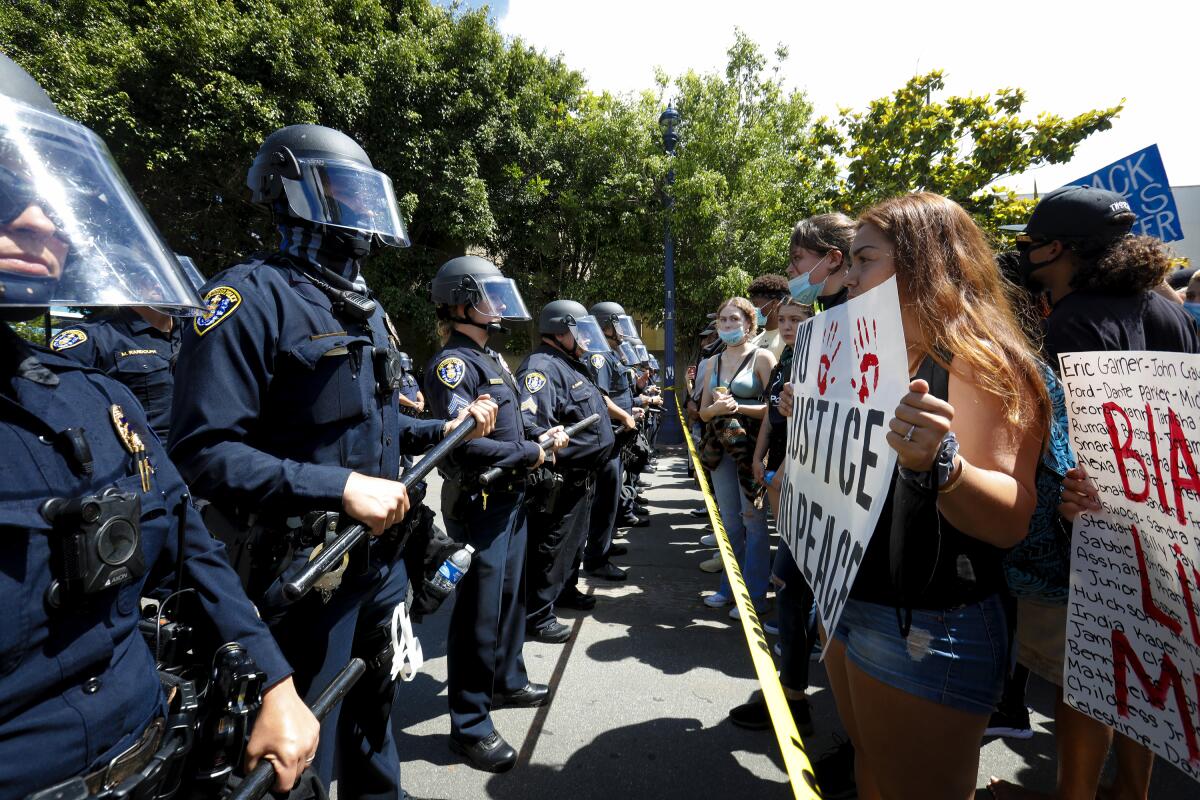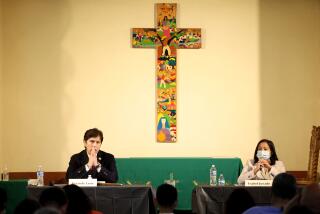San Diego mayor proposes greater scrutiny on police use of military weapons

- Share via
SAN DIEGO — The use of military weapons and equipment by San Diego police would face greater scrutiny and be more transparent to the public under a new policy Mayor Todd Gloria says he will unveil next month.
The policy is in response to complaints that the Police Department used surplus military equipment to help quell some of the many protests against police violence that took place across the city last year.
Gloria’s staff says the mayor wants there to be unambiguous criteria for when the Police Department can buy military weapons and equipment, what types of items they can buy and in what circumstances those items can be used.
The policy, which Gloria is scheduled to present to the City Council’s public safety committee Sept. 22, also would require that the public be notified when the Police Department acquires any military-grade equipment.
Gloria’s staff also is working with Police Chief David Nisleit and his staff to determine precisely when military equipment, particularly tanks or armored support vehicles, can be used.
The mayor tentatively plans to include on that list terrorist attacks, active shooter situations and hostage rescues, but his staff said the list could change before the proposed policy is unveiled.
A leading advocate for local police reform called Gloria’s new policy a step in the right direction but said she would prefer if the mayor planned to also eliminate the military weapons and equipment the city already has.
“We haven’t seen anything go away yet,” said Francine Maxwell, president of the local NAACP chapter. “And we have some of the latest and greatest.”
Maxwell said Gloria needs to go further.
“Unless we have a culture shift, it won’t create the trust we need,” she said.
The labor union representing police officers is expressing no objections to the new policy but wants to ensure local officers will continue to have access to medical supplies they get from the military, such as gauze pads and clotting agents. Jack Schaeffer, union president, said those supplies can be crucial when someone has been shot, stabbed or in a serious car crash.
Schaeffer said the city hasn’t gotten military weapons through the program in many years.
“It’s not going to be a big deal for us,” he said.
The proposed policy is part of a package of police reforms Gloria announced last spring that he says will increase police accountability and transparency of police decision-making.
Other proposals address the use of tear gas and gang injunctions, as well as police hiring practices and training focused on reducing racial bias.
“It’s time for the city to take a hard look at and update its police practices for modern times,” Gloria said. “Every San Diegan should feel safe in our city and have trust in our Police Department.”
Gloria also announced in early August that he has severed the city’s Office of Homeland Security from the Police Department and renamed the newly independent agency the Office of Emergency Services.
On the military equipment policy, city and police officials are conducting an inventory of what militarized weapons and equipment the Police Department already has. Law enforcement agencies often acquire such items through the Defense Department’s 1033 Program.
The program, which dates to the 1990s, transfers excess military equipment to civilian law enforcement agencies. Through 2020, 8,200 local law enforcement agencies had participated in the program and received more than $5.1 billion in military material.
Weapons acquired through the program include assault rifles, ballistics and grenade launchers. Equipment acquired through the program often includes vehicles, radios and other communications devices.
President Obama in 2015 restricted some items from going to police agencies, including repurposed grenade launchers and other heavy-duty equipment, saying such items “can alienate and intimidate local residents and send the wrong message.” The Trump administration rescinded those limits in 2017.
Some protesters and social justice advocates have criticized San Diego for having its officers wear tactical gear during protests and for using “tanks” to intimidate protesters.
Police Department officials say they don’t have any tanks, but the department does have an armored support vehicle, which is less sturdy than a tank but is designed to move multiple people and gear.
Complaints about last year’s protests already prompted the Police Department to unveil in March new parameters on how officers can respond, including when they should give dispersal orders and when they can fire rubber bullets.
The parameters also say the department’s goals are to ensure that rallies stay peaceful, prevent criminal activities, control traffic and “facilitate the safe exercise of an individual or a group’s First Amendment rights.”
City officials say they are basing the new military equipment policy on a similar policy adopted years ago by the state of Montana Many other cities have used that policy as a model.
Gloria says severing the city’s Office of Homeland Security from the Police Department will refocus city efforts on disaster preparedness, including wildfires, and will clarify some responsibilities.
“Responding to a disaster is about providing the critical services San Diegans need to endure and recover — that’s why my administration has proposed this change,” Gloria said. “The new Office of Emergency Services positions the city to better respond in times of crisis with a coordinated, regional approach that will make San Diego safer for all of us.”
The new agency will be led by former city Fire Deputy Chief Christopher Heiser.
More to Read
Sign up for Essential California
The most important California stories and recommendations in your inbox every morning.
You may occasionally receive promotional content from the Los Angeles Times.











